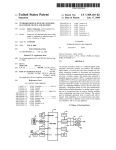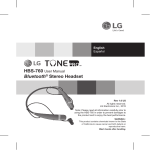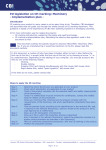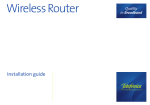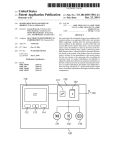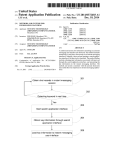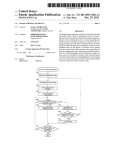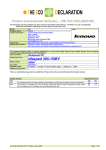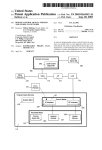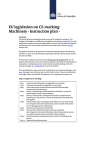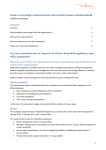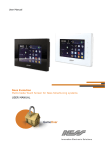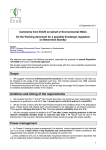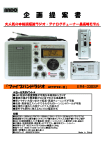Download B M4 COMMISSION REGULATION (EC) No 1275/2008 of 17
Transcript
2008R1275 — EN — 12.09.2013 — 004.001 — 1 This document is meant purely as a documentation tool and the institutions do not assume any liability for its contents ►M4 COMMISSION REGULATION (EC) No 1275/2008 ►B of 17 December 2008 implementing Directive 2005/32/EC of the European Parliament and of the Council with regard to ecodesign requirements for standby and off mode, and networked standby, electric power consumption of electrical and electronic household and office equipment ◄ (Text with EEA relevance) (OJ L 339, 18.12.2008, p. 45) Amended by: Official Journal No ►M1 ►M2 ►M3 ►M4 Commission Commission Commission Commission Regulation Regulation Regulation Regulation (EC) (EC) (EU) (EU) No No No No 278/2009 642/2009 617/2013 801/2013 of of of of 6 April 2009 22 July 2009 26 June 2013 22 August 2013 L L L L 93 191 175 225 page 3 42 13 1 date 7.4.2009 23.7.2009 27.6.2013 23.8.2013 2008R1275 — EN — 12.09.2013 — 004.001 — 2 ▼B ▼M4 COMMISSION REGULATION (EC) No 1275/2008 of 17 December 2008 implementing Directive 2005/32/EC of the European Parliament and of the Council with regard to ecodesign requirements for standby and off mode, and networked standby, electric power consumption of electrical and electronic household and office equipment ▼B (Text with EEA relevance) THE COMMISSION OF THE EUROPEAN COMMUNITIES, Having regard to the Treaty establishing the European Community, Having regard to Directive 2005/32/EC of the European Parliament and of the Council of 6 July 2005 establishing a framework for the setting of ecodesign requirements for energy-using products and amending Council Directive 92/42/EEC and Directives 96/57/EC and 2000/55/EC of the European Parliament and of the Council (1), and in particular Article 15(1) thereof, After consulting the Ecodesign Consultation Forum, Whereas: (1) Under Directive 2005/32/EC ecodesign requirements shall be set by the Commission for energy-using products representing significant volumes of sales and trade, having significant envi ronmental impact and presenting significant potential for improvement in terms of their environmental impact without entailing excessive costs. (2) Article 16(2) second indent of Directive 2005/32/EC provides that in accordance with the procedure referred to in Article 19(3) and the criteria set out in Article 15(2), and after consulting the Consultation Forum, the Commission shall as appropriate introduce a separate implementing measure reducing standby losses for a group of products. (3) The Commission has carried out a preparatory study which analysed the technical, environmental and economic aspects of standby mode and off-mode losses. The study has been developed together with stakeholders and interested parties from the EU and third countries, and the results have been made publicly available. (1) OJ L 191, 22.7.2005, p. 29. 2008R1275 — EN — 12.09.2013 — 004.001 — 3 ▼B (4) It has been stated in the preparatory study that standby func tionalities and off-mode losses occur for the majority of electrical and electronic household and office equipment products sold in the Community, while the annual electricity consumption related to standby functionalities and off-mode losses in the Community has been estimated to be 47 TWh in 2005, corresponding to 19 Mt CO2 emissions. Without taking specific measures, the consumption is predicted to increase to 49 TWh in 2020. It has been concluded that the electricity consumption of standby func tionalities and off-mode losses can be significantly reduced. (5) Improvements of electricity consumption of standby func tionalities and off-mode losses should be achieved by applying existing non-proprietary cost-effective technologies, which lead to a reduction of the combined expenses for purchasing and operating equipment. (6) Ecodesign requirements for the power consumption of standby mode and off mode of electrical and electronic household and office equipment should be set with a view to harmonising ecodesign requirements on standby mode and off mode throughout the Community and contributing to the functioning of the internal market and to improvement of the environmental performance of the products affected. (7) The ecodesign requirements should not have negative impact on the functionality of the product and should not affect negatively health, safety and environment. In particular, the benefits of reducing the electricity consumption during the use phase should over-compensate potential additional environmental impacts during the production phase of equipment having standby functionalities and/or off-mode losses. (8) The application of this Regulation should be limited to products corresponding to household and office equipment intended for use in the domestic environment, which, for information tech nology equipment, corresponds to class B equipment as set out in EN 55022:2006. The scope should be defined such that equipment that is not yet available on the market, but have similar functionalities to those products explicitly named in this Regulation, are designed to fulfil the requirements. When appro priate, an amendment to this Regulation can complement the list of products. (9) Operating modes not covered by this Regulation, such as the ACPI S3 mode of computers, should be considered in product-specific implementing measures pursuant to Directive 2005/32/EC. (10) As a general rule, requirements on standby and off mode set out in product-specific implementing measures pursuant to Directive 2005/32/EC should not be less ambitious than those set out in this Regulation. 2008R1275 — EN — 12.09.2013 — 004.001 — 4 ▼B (11) In order to prevent unnecessary losses of energy, products should ideally enter into a ‘0-Watt’ consumption state when providing no function. The technical feasibility and appropriateness should be considered on a product-by-product basis in the relevant implementing measure pursuant to Directive 2005/32/EC. (12) The two-staged entry into force of the ecodesign requirements should provide an appropriate time-frame for manufacturers to redesign products as far as standby functionalities and off-mode losses are concerned. The timing of the stages should be set in such a way that negative impacts related to functionalities of equipment on the market are avoided, and cost impacts for manu facturers, in particular SMEs, are taken into account, while ensuring timely achievement of policy objectives. Measurements of the power consumption should be performed taking into account the generally recognised state of the art; manufacturers may apply harmonised standards in accordance with Article 9 of Directive 2005/32/EC. (13) This Regulation should increase the market penetration of tech nologies yielding improved energy efficiency for standby func tionalities and off-mode losses, leading to estimated energy savings of 35 TWh in 2020, compared to a business-as-usual scenario. (14) Pursuant to Article 8(2) of Directive 2005/32/EC, this Regulation should specify that the applicable conformity assessment procedures are the internal design control set out in Annex IV and the management system set out in Annex V to Directive 2005/32/EC. (15) In order to facilitate compliance checks, manufacturers should be requested to provide information in the technical documentation referred to in Annexes IV and V to Directive 2005/32/EC on the operating conditions subject to the definitions of standby/off mode, and the corresponding power consumption levels. (16) Benchmarks for currently available technologies with low standby and off mode power consumption should be identified. This helps to ensure wide availability and easy access to information, in particular for SMEs and very small firms, which further facilitates the integration of best-design tech nologies for reducing the energy consumption of standby and off mode. (17) The measures provided for in this Regulation are in accordance with the opinion of the Committee established by Article 19(1) of Directive 2005/32/EC, 2008R1275 — EN — 12.09.2013 — 004.001 — 5 ▼B HAS ADOPTED THE FOLLOWING REGULATION: ▼M4 Article 1 Subject matter and scope This Regulation establishes ecodesign requirements related to standby and off mode, and networked standby, electric power consumption for the placing on the market of electrical and electronic household and office equipment. This Regulation shall not apply to electrical and electronic household and office equipment placed on the market with a low voltage external power supply to work as intended. ▼B Article 2 Definitions For the purposes of this Regulation, the definitions set out in Directive 2005/32/EC shall apply. The following definitions shall also apply: 1. ‘electrical and electronic household and office equipment’ (hereafter referred to as ‘equipment’), means any energy-using product which: (a) is made commercially available as a single functional unit and is intended for the end-user; (b) falls under the list of energy-using products of Annex I; (c) is dependent on energy input from the mains power source in order to work as intended; and (d) is designed for use with a nominal voltage rating of 250 V or below, also when marketed for non-household or non-office use; 2. ‘standby mode(s)’ means a condition where the equipment is connected to the mains power source, depends on energy input from the mains power source to work as intended and provides only the following functions, which may persist for an indefinite time: — reactivation function, or reactivation function and only an indi cation of enabled reactivation function, and/or — information or status display; 3. ‘reactivation function’ means a function facilitating the activation of other modes, including active mode, by remote switch, including remote control, internal sensor, timer to a condition providing additional functions, including the main function; 2008R1275 — EN — 12.09.2013 — 004.001 — 6 ▼B 4. ‘information or status display’ means a continuous function providing information or indicating the status of the equipment on a display, including clocks; 5. ‘active mode(s)’ means a condition in which the equipment is connected to the mains power source and at least one of the main function(s) providing the intended service of the equipment has been activated; 6. ‘off mode’ means a condition in which the equipment is connected to the mains power source and is not providing any function; the following shall also be considered as off mode: (a) conditions providing only an indication of off-mode condition; (b) conditions providing only functionalities intended to ensure electromagnetic compatibility pursuant to Directive 2004/108/EC of the European Parliament and of the Council (1); 7. ‘information technology equipment’ means any equipment which has a primary function of either entry, storage, display, retrieval, transmission, processing, switching, or control, of data and of tele communication messages or a combination of these functions and may be equipped with one or more terminal ports typically operated for information transfer; 8. ‘domestic environment’ means an environment where the use of broadcast radio and television receivers may be expected within a distance of 10 m of the apparatus concerned ; ▼M1 9. ‘low voltage external power supply’ means an external power supply with a nameplate output voltage of less than 6 volts and a nameplate output current greater than or equal to 550 milliamperes; ▼M4 10. ‘network’ means a communication infrastructure with a topology of links, an architecture, including the physical components, organisa tional principles, communication procedures and formats (proto cols); 11. ‘networked standby’ means a condition in which the equipment is able to resume a function by way of a remotely initiated trigger from a network connection; 12. ‘remotely initiated trigger’ means a signal that comes from outside the equipment via a network; 13. ‘network port’ means a wired or wireless physical interface of the network connection located on the equipment through which the equipment can be remotely activated; 14. ‘logical network port’ means the network technology running over a physical network port; 15. ‘physical network port’ means the physical (hardware) medium of a network port. A physical network port can host two or more network technologies; (1) OJ L 390, 31.12.2004, p. 24. 2008R1275 — EN — 12.09.2013 — 004.001 — 7 ▼M4 16. ‘network availability’ means the capability of the equipment to resume functions after a remotely initiated trigger has been detected by a network port; 17. ‘networked equipment’ means equipment that can connect to a network and has one or more network ports; 18. ‘networked equipment with high network availability’ (HiNA equipment) means equipment with one or more of the following functionalities, but no other, as the main function(s): router, network switch, wireless network access point, hub, modem, VoIP telephone, video phone; 19. ‘networked equipment with high network availability functionality’ (equipment with HiNA functionality) means equipment with the functionality of a router, network switch, wireless network access point or combination thereof included, but not being HiNA equipment; 20. ‘router’ means a network device whose primary function is to determine the optimal path along which network traffic should be forwarded. Routers forward packets from one network to another, based on network layer information (L3); 21. ‘network switch’ means a network device whose primary function is to filter, forward and distribute frames based on the destination address of each frame. All switches operate at least at the data link layer (L2); 22. ‘wireless network access point’ means a device whose primary function is to provide IEEE 802.11 (Wi-Fi) connectivity to multiple clients; 23. ‘hub’ means a network device that contains multiple ports and is used to connect segments of a Local Area Network; 24. ‘modem’ means a device whose primary function is to transmit and receive digitally modulated analogue signals over a wired network; 25. ‘printing equipment’ means equipment that generates paper output from electronic input. Printing equipment may have additional functions and may be marketed as a multifunctional device or multifunctional product; 26. ‘large format printing equipment’ means printing equipment designed for printing on A2 media and larger, including equipment designed to accommodate continuous-form media of at least 406 mm width; 27. ‘tele-presence system’ means a dedicated system for high-definition video conferencing and collaboration which includes a user interface, a high-definition camera, a display, a sound system and processing capabilities for encoding and decoding video and audio; 2008R1275 — EN — 12.09.2013 — 004.001 — 8 ▼M4 28. ‘household coffee machine’ means a non-commercial appliance for brewing coffee; 29. ‘drip filter household coffee machine’ means a household coffee machine which uses percolation to extract the coffee; 30. ‘heating element’ means a component of the coffee machine which converts electricity into heat to warm up water; 31. ‘cup preheating’ means a function for warming cups that are stored on the coffee machine; 32. ‘brewing cycle’ means the process that has to be completed to produce coffee; 33. ‘self-cleaning’ means a process that the coffee machine carries out to clean its interior. This process can either be a simple rinse or a washing process using specific additives; 34. ‘descaling’ means a process that the coffee machine carries out to remove totally or partially potential scale in its interior; 35. ‘desktop thin client’ means a computer that relies on a connection to remote computing resources (e.g. computer server, remote work station) to obtain primary functionality and has no rotational storage media integral to the product. The main unit of a desktop thin client must be intended for use in a permanent location (e.g. on a desk) and not for portability. Desktop thin clients can output information to either an external or, where included with the product, an internal display; 36. ‘workstation’ means a high-performance, single-user computer primarily used for graphics, Computer Aided Design, software development, financial and scientific applications among other compute intensive tasks, and which has the following character istics: (a) has a mean time between failures (MTBF) of at least 15 000 hours; (b) has error-correcting code (ECC) and/or buffered memory; (c) meets three of the following five characteristics: (1) has supplemental power support for high-end graphics (i.e. peripheral component interconnect (PCI)-E 6-pin 12 V supplemental power feed); (2) its system is wired for greater than × 4 PCI-E on the motherboard in addition to the graphics slot(s) and/or PCI-X support; (3) does not support uniform memory access (UMA) graphics; (4) includes five or more PCI, PCI-E or PCI-X slots; 2008R1275 — EN — 12.09.2013 — 004.001 — 9 ▼M4 (5) is capable of multi-processor support for two or more CPU (must support physically separate CPU packages/sockets, i.e. not met with support for a single multi core CPU); 37. ‘mobile workstation’ means a high-performance, single-user computer primarily used for graphics, Computer Aided Design, software development, financial and scientific applications among other compute intensive tasks, excluding game play, and which is designed specifically for portability and to be operated for extended periods of time either with or without a direct connection to an AC power source. Mobile workstations utilise an integrated display and are capable of operation on an integrated battery or other portable power source. Most mobile workstations use an external power supply and most have an integrated keyboard and pointing device. A mobile workstation has the following characteristics: (a) has a mean time between failures (MTBF) of at least 13 000 hours; (b) has at least one discrete graphics card (dGfx) meeting the G3 (with FB Data Width > 128-bit), G4, G5, G6 or G7 classifi cation; (c) supports the inclusion of three or more internal storage devices; (d) supports at least 32 GB of system memory; 38. ‘small-scale server’ means a type of computer that typically uses desktop computer components in a desktop form factor but is designed primarily to be a storage host for other computers and to perform functions such as providing network infrastructure services and hosting data/media, and which has the following char acteristics: (a) is designed in a pedestal, tower, or other form factor similar to those of desktop computers such that all data processing, storage, and network interfacing is contained within one box; (b) is designed to be operational 24 hours per day and 7 days per week; (c) is primarily designed to operate in a simultaneous multi-user environment serving several users through networked client units; (d) where placed on the market with an operating system, the operating system is designed for home server or low-end server applications; 2008R1275 — EN — 12.09.2013 — 004.001 — 10 ▼M4 (e) is not placed on the market with a discrete graphics card (dGfx) meeting any classification other than G1; 39. ‘computer server’ means a computing product that provides services and manages networked resources for client devices, such as desktop computers, notebook computers, desktop thin clients, internet protocol (IP) telephones, or other computer servers. A computer server is typically placed on the market for use in data centres and office/corporate environments. A computer server is primarily accessed via network connections, and not through direct user input devices, such as a keyboard or a mouse; A computer server has the following characteristics: (a) is designed to support computer server operating systems (OS) and/or hypervisors, and targeted to run user-installed enterprise applications; (b) supports error-correcting code (ECC) and/or buffered memory (including both buffered dual in-line memory modules (DIMMs) and buffered on board (BOB) configurations); (c) is placed on the market with one or more AC-DC power supply(ies); (d) all processors have access to shared system memory and are independently visible to a single OS or hypervisor. Article 3 Ecodesign requirements The ecodesign requirements related to standby and off mode, and networked standby electric power consumption, are set out in Annex II. ▼B Article 4 Conformity assessment The procedure for assessing conformity referred to in Article 8(2) of Directive 2005/32/EC shall be the internal design control system set out in Annex IV to Directive 2005/32/EC or the management system set out in Annex V to Directive 2005/32/EC. 2008R1275 — EN — 12.09.2013 — 004.001 — 11 ▼B Article 5 Verification procedure for market surveillance purposes Surveillance checks shall be carried out in accordance with the verifi cation procedure set out in Annex III. Article 6 Benchmarks The indicative benchmarks for the best-performing products and tech nology currently available on the market are identified in Annex IV. ▼M4 Article 7 Revision The Commission shall review this Regulation and present the results of the review to the Consultation Forum no later than 7 January 2016, in the light of technological progress. The review will in particular address the scope and the requirements for standby/off mode and the appropri ateness and level of the requirements for networked standby with regard to the third stage of implementation (2019). The review could address, inter alia, professional equipment and products equipped with electric motors operated by remote control. Article 8 Entry into force This Regulation shall enter into force on the twentieth day following that of its publication in the Official Journal of the European Union. Point 1 of Annex II shall apply as from 7 January 2010. Point 2 of Annex II shall apply as from 7 January 2013. Point 3 of Annex II shall apply as from 1 January 2015. Point 4 of Annex II shall apply as from 1 January 2017. Point 5 of Annex II shall apply as from 1 January 2019. Point 6 of Annex II shall apply as from 1 January 2015. Point 7 of Annex II shall apply as from 1 January 2015. This Regulation shall be binding in its entirety and directly applicable in all Member States. 2008R1275 — EN — 12.09.2013 — 004.001 — 12 ▼B ANNEX I List of energy-using products covered by this Regulation 1. Household appliances Washing machines Clothes dryers Dish washing machines Cooking: Electric ovens Electric hot plates Microwave ovens Toasters Fryers Grinders, coffee machines and equipment for opening or sealing containers or packages Electric knives Other appliances for cooking and other processing of food, cleaning, and maintenance of clothes Appliances for hair cutting, hair drying, tooth brushing, shaving, massage and other body care appliances Scales ▼M3 2. Information technology equipment intended primarily for use in the domestic environment, but excluding desktop computers, integrated desktop computers and notebook computers as defined in Commission Regulation (EU) No 617/2013 (1) ▼B 3. Consumer equipment ▼M2 Radio sets Videocameras Video recorders Hi-fi recorders Audio amplifiers Home theatre systems Musical instruments And other equipment for the purpose of recording or reproducing sound or images, including signals or other technologies for the distribution of sound and image other than by telecommunications, but excluding televisions as defined in Commission Regulation (EC) No 642/2009 ▼B 4. Toys, leisure and sports equipment Electric trains or car racing sets Hand-held video game consoles Sports equipment with electric or electronic components Other toys, leisure and sport equipment (1) OJ L 175, 27.6.2013, p. 13. 2008R1275 — EN — 12.09.2013 — 004.001 — 13 ▼B ANNEX II Ecodesign requirements 1. One year after this Regulation has come into force: (a) Power consumption in ‘off mode’: Power consumption of equipment in any off-mode condition shall not exceed 1,00 W. (b) Power consumption in ‘standby mode(s)’: The power consumption of equipment in any condition providing only a reactivation function, or providing only a reactivation function and a mere indication of enabled reactivation function, shall not exceed 1,00 W. The power consumption of equipment in any condition providing only information or status display, or providing only a combination of reacti vation function and information or status display, shall not exceed 2,00 W. (c) Availability of off mode and/or standby mode Equipment shall, except where this is inappropriate for the intended use, provide off mode and/or standby mode, and/or another condition which does not exceed the applicable power consumption requirements for off mode and/or standby mode when the equipment is connected to the mains power source. 2. Four years after this Regulation has come into force: (a) Power consumption in ‘off mode’: Power consumption of equipment in any off-mode condition shall not exceed 0,50 W. (b) Power consumption in ‘standby mode(s)’: The power consumption of equipment in any condition providing only a reactivation function, or providing only a reactivation function and a mere indication of enabled reactivation function, shall not exceed 0,50 W. The power consumption of equipment in any condition providing only information or status display, or providing only a combination of reacti vation function and information or status display shall not exceed 1,00 W. (c) Availability of off mode and/or standby mode Equipment shall, except where this is inappropriate for the intended use, provide off mode and/or standby mode, and/or another condition which does not exceed the applicable power consumption requirements for off mode and/or standby mode when the equipment is connected to the mains power source. ▼M4 (d) Power management for all equipment other than networked equipment Equipment shall, unless inappropriate for the intended use, offer a power management function or a similar function. When equipment is not providing the main function, and other energy-using product(s) are not dependent on its functions, the power management function shall switch equipment after the shortest possible period of time appropriate for the intended use of the equipment, automatically into: — standby mode, or — off mode, or 2008R1275 — EN — 12.09.2013 — 004.001 — 14 ▼M4 — another condition which does not exceed the applicable power consumption requirements for off mode and/or standby mode when the equipment is connected to the mains power source. The power management function shall be activated. 3. As of 1 January 2015: (a) Possibility of deactivating wireless network connection(s) Any networked equipment that can be connected to a wireless network shall offer the user the possibility to deactivate the wireless network connection(s). This requirement does not apply to products which rely on a single wireless network connection for intended use and have no wired network connection. (b) Power management for networked equipment Equipment shall, unless inappropriate for the intended use, offer a power management function or a similar function. When equipment is not providing a main function, and other energy-using product(s) are not dependent on its functions, the power management function shall switch equipment after the shortest possible period of time appropriate for the intended use of the equipment, automatically into a condition having networked standby. In a condition providing networked standby, the power management function may switch equipment automatically into standby mode or off mode or another condition which does not exceed the applicable power consumption requirements for standby and/or off mode. The power management function, or a similar function, shall be available for all network ports of the networked equipment. The power management function, or a similar function, shall be activated, unless all network ports are deactivated. In that latter case the power management function, or a similar function, shall be activated if any of the network ports is activated. The default period of time after which the power management function, or a similar function, switches the equipment automatically into a condition providing networked standby shall not exceed 20 minutes. (c) Networked equipment that has one or more standby modes shall comply with the requirements for these standby mode(s) when all network ports are deactivated. (d) Networked equipment other than HiNA equipment shall comply with the provisions under 2(d) when all network ports are deactivated. (e) Power consumption in a condition providing networked standby: The power consumption of HiNA equipment or equipment with HiNA functionality in a condition providing networked standby into which the equipment is switched by the power management function, or a similar function shall not exceed 12,00 W. The power consumption of other networked equipment in a condition providing networked standby into which the equipment is switched by the power management function, or a similar function, shall not exceed 6,00 W. 2008R1275 — EN — 12.09.2013 — 004.001 — 15 ▼M4 The power consumption limits as stipulated in point (e) shall not apply to: (i) printing equipment with a power supply of a rated power larger than 750 W; (ii) large format printing equipment; (iii) tele-presence systems; (iv) desktop thin clients; (v) workstations; (vi) mobile workstations; (vii) small-scale servers; (viii) computer servers. 4. As of 1 January 2017: In addition to the requirements set out in point 3(a) and (b), the following provisions shall apply: (a) Networked equipment that has one or more standby mode(s) shall comply with the requirements for these standby mode(s) when all wired network ports are disconnected and when all wireless network ports are deacti vated. (b) Networked equipment other than HiNA equipment shall comply with the provisions under 2(d) when all wired network ports are disconnected and when all wireless network ports are deactivated. (c) Power consumption in a condition providing ‘networked standby’: The power consumption of HiNA equipment or equipment with HiNA functionality, in a condition providing networked standby into which the equipment is switched by the power management function, or a similar function, shall not exceed 8,00 W. The power consumption of other networked equipment in a condition providing networked standby into which the equipment is switched by the power management function, or a similar function, shall not exceed 3,00 W. The power consumption limits as stipulated in point (c) shall not apply to: (i) large format printing equipment; (ii) desktop thin clients; (iii) workstations; (iv) mobile workstations; (v) small-scale servers; (vi) computer servers. 5. As of 1 January 2019: In addition to the requirements set out in point 3(a) and (b) and point 4(a), (b) and (c), the following provision shall apply for networked equipment other than HiNA equipment or other than equipment with HiNA-functionality: 2008R1275 — EN — 12.09.2013 — 004.001 — 16 ▼M4 The power consumption of networked equipment other than HiNA equipment or other than equipment with HiNA functionality, in a condition providing networked standby into which the equipment is switched by the power management function, or a similar function, shall not exceed 2,00 W. 6. As of 1 January 2015: For coffee machines, the delay time after which the product switches auto matically into the modes and conditions referred to in Annex II, point 2, paragraph (d) shall be as follows: — for domestic drip filter coffee machines storing the coffee in an insulated jug, a maximum of five minutes after completion of the last brewing cycle or 30 minutes after completion of a descaling or self-cleaning process, — for domestic drip filter coffee machines storing the coffee in a noninsulated jug, a maximum of 40 minutes after completion of the last brewing cycle, or 30 minutes after completion of a descaling or self-cleaning process, — for domestic coffee machines other than drip filter coffee machines, a maximum of 30 minutes after completion of the last brewing cycle, or a maximum of 30 minutes after activation of the heating element, or a maximum of 60 minutes after activation of the cup preheating function, or a maximum of 30 minutes after completion of a descaling or self-cleaning process, unless an alarm has been triggered requiring users’ intervention to prevent possible damage or accident. Until the above date the ecodesign requirements set out in Annex II.2.d shall not apply. 7. Product information requirements As of 1 January 2015, the following information for networked equipment shall be visibly displayed on manufacturers’ freely accessible websites: (a) for each standby and/or off mode and the condition providing networked standby into which the equipment is switched by the power management function or similar function: — the power consumption data in Watt rounded to the first decimal place, — the period of time after which the power management function, or a similar function, switches the equipment automatically into standby and/or off mode and/or the condition providing networked standby; (b) the power consumption of the product in networked standby if all wired network ports are connected and all wireless network ports are activated; (c) guidance on how to activate and deactivate wireless network ports. The power consumption of the product in networked standby as referred to in point (b) and the guidance as referred to in point (c) shall also be included in the user manual. 2008R1275 — EN — 12.09.2013 — 004.001 — 17 ▼M4 8. Measurements The power consumption referred to in point 1(a) and (b), point 2(a) and (b), points 3(e) and 4(c) and point 5, and the delay times referred to in point 6, shall be established by a reliable, accurate and reproducible measurement procedure, which takes into account the generally recognised state of the art. 9. Information to be provided by manufacturers For the purposes of conformity assessment pursuant to Article 4, the technical documentation shall contain the following elements: (a) for each standby and/or off mode: — the power consumption data in Watt rounded to the first decimal place, — the measurement method used, — a description of how the equipment mode was selected or programmed, — the sequence of events leading to the condition where the equipment automatically changes modes, — any notes regarding the operation of the equipment, e.g. information on how the user switches the equipment into a condition having networked standby, — if applicable, the default time after which the power management function, or similar function, has switched the equipment into the applicable low power mode or condition; (b) for networked equipment: — the number and type of network ports and, with the exception of wireless network ports, where these ports are located on the equipment; in particular it shall be declared if the same physical network port accommodates two or more types of network ports, — whether all network ports are deactivated before delivery, — whether the equipment qualifies as HiNA equipment or equipment with HiNa functionality; where no information is provided, this is considered not to be the case; and for each type of network port: — the default time after which the power management function, or a similar function, switches the equipment into a condition providing networked standby, — the trigger that is used to reactivate the equipment, — the (maximum) performance specifications, — the (maximum) power consumption of the equipment in a condition providing networked standby into which the power management function, or a similar function, will switch the equipment, if only this port is used for remote activation, — the communication protocol used by the equipment; If no information is provided, the equipment is considered not to be networked equipment unless it provides the functionalities of a router, network switch, wireless network access point (not being a terminal), hub, modem, VoIP telephone, video phone. 2008R1275 — EN — 12.09.2013 — 004.001 — 18 ▼M4 (c) test parameters for measurements: — ambient temperature, — test voltage in V and frequency in Hz, — total harmonic distortion of the electricity supply system, — information and documentation on the instrumentation, set-up and circuits used for electrical testing; (d) the equipment characteristics relevant for assessing conformity with the requirements set out in point 1(c), or the requirements set out in points 2(c) and/or 2(d) and/or 3(b), as applicable, including the time taken to automatically reach standby, or off mode, or another condition which does not exceed the applicable power consumption requirements for off mode and/or standby mode. In particular, if applicable, a technical justification shall be provided that the requirements set out in point 1(c), or the requirements set out in points 2(c) and/or 2(d) and/or 3(b), are inappropriate for the intended use of equipment. The need to maintain one or more network connections or to wait for a remotely initiated trigger is not considered a technical justification for exemption from the requirements set out in 2(d) in the case of equipment that is not defined as networked equipment by the manufacturer. 2008R1275 — EN — 12.09.2013 — 004.001 — 19 ▼B ANNEX III Verification procedure When performing the market surveillance checks referred to in Directive 2005/32/EC, Article 3(2), the authorities of the Member State shall apply the following verification procedure for the requirements set out in Annex II, points 1(a) and 1(b), or points 2(a) and 2(b), as applicable. For power consumption requirements larger than 1,00 W, Member State auth orities shall test one single unit. The model shall be considered to comply with the provisions set out in Annex II, points 1(a) and 1(b), or points 2(a) and 2(b), as applicable, to this Regulation if the results for off-mode and standby-mode conditions, as applicable, do not exceed the limit values by more than 10 %. Otherwise, three more units shall be tested. The model shall be considered to comply with this Regulation if the average of the results of the latter three tests for off-mode and/or standby-mode conditions, as applicable, does not exceed the limit values by more than 10 %. For power consumption requirements smaller than, or equal to, 1,00 W, Member State authorities shall test one single unit. The model shall be considered to comply with the provisions set out in Annex II, points 1(a) and 1(b), or points 2(a) and 2(b), as applicable, to this Regulation if the results for off-mode and/or standby-mode conditions, as applicable, do not exceed the limit values by more than 0,10 W. Otherwise, three more units shall be tested. The model shall be considered to comply with this Regulation if the average of the results of the latter three tests for off-mode and/or standby-mode conditions, as applicable, does not exceed the limit values by more than 0,10 W. Otherwise, the model shall be considered not to comply. ▼M4 Regarding the requirements set out in Annex II, point 2(d), Member States’ authorities shall use the applicable procedure above to measure the power consumption after the power management function, or similar function, has switched the equipment into the applicable mode or condition. Regarding the requirements set out in Annex II, points 3(c) and 4(a) Member States authorities shall use the applicable procedure above, after having deac tivated and/or disconnected, as applicable, all network ports of the unit. When performing the market surveillance checks referred to in Article 3(2) of Directive 2009/125/EC of the European Parliament and of the Council (1), the Member States’ authorities shall apply the following verification procedure for the requirements set out in Annex II, points 3 and 4, as applicable. Member States’ authorities shall test one single unit as follows: If the equipment has, as indicated in the technical documentation, one type of network port and if two or more ports of that type are available, one of these ports is randomly chosen and that port is connected to the appropriate network complying with the maximum specification of the port. In the event of multiple wireless network ports of the same type, the other wireless ports shall be deac tivated if possible. In the event of multiple wired network ports of the same type for verifying requirements set out in Annex II, point 3, the other network ports shall be deactivated if possible. If only one network port is available, that port is connected to the appropriate network complying with the maximum specification of the port. (1) OJ L 285, 31.10.2009, p. 10. 2008R1275 — EN — 12.09.2013 — 004.001 — 20 ▼M4 The unit is put in on mode. Once the unit in on mode is working properly, it is allowed to go into the condition providing networked standby and the power consumption is measured. Then the appropriate trigger is given to the equipment through the network port and a check is made on whether the equipment is reactivated. If the equipment has, as indicated in the technical documentation, more than one type of network port for each type of network port the following procedure is repeated. If two or more network ports of a type are available, one port is chosen randomly for each type of network port and that port is connected to the appro priate network complying with the maximum specification of the port. If for a certain type of network port only one port is available, that port is connected to the appropriate network complying with the maximum specification of the port. Wireless ports not used shall be deactivated if possible. In the event of verification of requirements set out in Annex II, point 3, the wired network ports not used shall be deactivated if possible. The unit is put in on mode. Once the unit in on mode is working properly, it is allowed to go into the condition providing networked standby and the power consumption is measured. Then the appropriate trigger is given to the equipment through the network port and a check is made whether the equipment is reacti vated. If one physical network port is shared by two or more types of (logical) network ports this procedure is repeated for each type of logical network port, with the other logical network ports being logical-disconnected. The model shall be considered to comply with this Regulation if the results for each type of network port do not exceed the limit value by more than 10 %. Otherwise, three more units shall be tested. The model shall be considered to comply with this Regulation if the average of the results for each type of network port of the latter three tests does not exceed the limit value by more than 10 %. Otherwise, the model shall be considered not to comply. The Member State authorities shall provide the test results and other relevant information to the authorities of the other Member States and to the Commission within one month of the decision being taken on the non-compliance of the model. In addition to the procedures set out above, Member States’ authorities shall use reliable, accurate and reproducible measurement procedures which take into account the generally recognised state of the art, including methods set out in documents the reference numbers of which have been published for that purpose in the Official Journal of the European Union. 2008R1275 — EN — 12.09.2013 — 004.001 — 21 ▼B ANNEX IV Benchmarks The following benchmarks are identified for the purpose of Annex I, Part 3, point 2, to Directive 2005/32/EC: Off mode: 0 W-0,3 W with hard-off switch on the primary side, depending, inter alia, on the characteristics related to electromagnetic compatibility pursuant to Directive 2004/108/EC. Standby — reactivation function: 0,1 W. Standby — display: simple displays and low power LEDs 0,1 W, larger displays (e.g. for clocks) require more power. ▼M4 Networked standby: 3 W for HiNA equipment; 1 W or less for non-HiNA equipment.





















